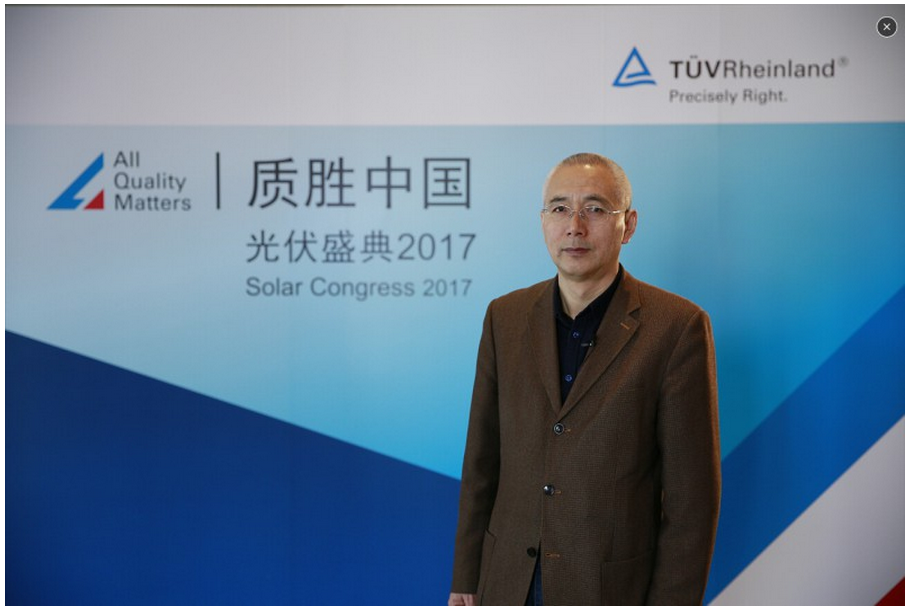On 13-14 March 2017, the “All Quality Matters” 2017 Solar Congress and Award Ceremony organized by the TÜV Rheinland Group (TÜV Rheinland) were held in Wuxi, Jiangsu. During the Congress, Professor Hui Shen, Director of the Institute for Solar Energy Systems at Sun Yat-sen University, gave an exclusive interview and discussed the overall development of China's photovoltaic (PV) industry, the PV Top Runner Programme and the effects of third-party inspection and certification institutions on the industry, among other issues.
Professor Shen stated that after more than a decade, a consensus had been reached that PV would play a crucial role in energy supply and in renewable energy. The accumulated installed PV capacity of China has currently reached up to 80 GW, which is a good sign, and has encouraged confidence in this newly emerging industry. China is now at the forefront of the global development of PV.

How do “Top Runners” control quality?
On June 3 2016, the National Energy Administration officially issued the Construction and Implementation Plan of PV Power Generation for 2016. The construction of newly added PV power plants led to an overall annual output of 18.1 GW, including ordinary PV power plant projects providing 12.6 GW and the PV “Top Runner” technology bases producing 5.5 GW, which accounts for 30% of the overall performance. The 2016 “PV Top Runner Programme”, led by the National Energy Administration, was concluded with the announcement on October 27 of the winning bid from the Wuhai Base in Inner Mongolia.
The “Photovoltaic PV Top Runner Programme” raised some doubts in the industry as it risked substantially lowering the PV benchmark on-grid price. The programme was viewed as triggering aggressive competition to achieve low prices and could therefore disrupt the industry. Other concerns included the fact that the resulting price drop is only a temporary phenomenon and the quality of the bidding projects cannot be guaranteed.
Professor Shen Hui stated that the National Energy Administration aims to encourage advanced technology and enterprises, eliminate backward production capacities and act as a benchmark through the “PV Top Runner Programme”. Overall and sustained development should not be ignored in the Programme, as quality control is an essential part of the progress and aggressive competition should be avoided at all costs. None of the power plants, including those listed in the “Top Runner Programme”, can be reported publicly on the day they are completed. Annual generating capacities and failure conditions will be reported in time and put on record, and long-term observations are also essential.
Establishing a record evaluation system for distributed PV
China’s PV industry enjoyed unprecedented development in 2016. According to the data released by the National Energy Administration, newly installed capacity was ranked top worldwide, exceeding 20 million KW in the first half of the year and reaching 34.54 million KW by the end of 2016, while the accumulated installed capacity reached 77.42 million KW.
Many favourable policies have been issued to encourage the development of the distributed PV industry, which has recently enjoyed a boom in China. According to the data, the accumulated installed capacity of distributed PV reached 10.32 million KW in China by the end of 2016. Industry insiders predict that the PV industry will gradually expand to central and eastern China, and will be dominated by distributed PV power plants. The numerous advantages of distributed PV will accelerate its further development, including user friendliness, self-production/consumption and surplus when connected to the grid.
Professor Shen believed that 2016 would be a significant year in the history of China’s PV industry. In 2015, the accumulated installed capacity of PV in China was less than 45 GW, but over the last year there was 34 GW of newly installed capacity, which is an outstanding achievement. Professor Shen predicted that the newly installed capacity would reach at least 20 GW in 2017, and stressed that PV workers gained confidence and optimism in 2016. The Professor added that sustained and healthy development of distributed PV would depend on the timely distribution of public subsidies, and that we should establish a record system and an evaluation system for distributed PV.
Concerns after “Great Leap Forward”
The recent policies have driven China’s PV industry to develop at a substantial pace. However, the relatively low investment threshold during the Installation Spree has led to various quality problems in the PV power plants built, including the nonstandard design of power plants, poor construction quality and substandard quality of parts, which has had a negative effect on the industry’s development.
Professor Shen stated that the development of the PV industry has been a long-term project. TÜV Rheinland has 40 years of experience in PV application and quality management in this field. It has provided us with guidance in terms of components, modules, inverters, etc. since it was first established in China. Quality control is necessary for China’s PV industry to be number one in the world, but the evaluation of PV power plants is complex. Assessing authentic first-hand data without standard and objective environmental assessment is difficult, so third-party inspection and certification institutions are thus particularly important. These institutions must provide their inspection methods, lay down regulations and operate scientifically and reasonably. Professor Shen believed that TÜV Rheinland was extremely professional in this respect, and selecting TÜV Rheinland to cooperate with Chinese enterprises would be beneficial.



